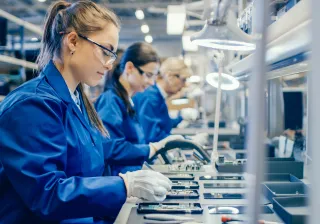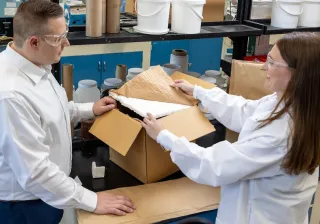The worldwide Earth Overshoot Day comes earlier every year − could a circular economy offer a solution? The circular economy is a mindset to take advantage of all global material flows, such as food and bio- and mineral-based raw materials, as efficiently as possible. This requires that both consumers and industrial manufacturers change their everyday practices.
Major environmental issues are at stake. The seas and marine species are full of plastic, the atmospheric carbon dioxide level is higher than ever before in the history of measurement, food scandals generate uncertainty, clean drinking water is running out, urbanisation is increasing traffic and worsening the pollution problems… Consumption is the thing that runs the world economy.
For example, as regards food, the circular economy is closely connected to elimination of waste and the use of side streams. In bio-based raw materials, we are investing in such matters as recycling of textiles and, in the future, increasingly in high added-value products. Good biomass should not be transformed into energy before we have gotten whatever we can out of the fibres first. Over various lifecycles.
Final users can make personal choices to encourage longer product lifecycles
In the consumer sector, clothing industry is an excellent example of how the turnover rate and trends change. Cheap clothing stores stormed into the Finnish market in the early 2000’s, the season lasted a few weeks − and so did the clothes. The Finnish clothing industry went bankrupt, because it was impossible to succeed in competition. This was the case until a growing number of consumers started to demand higher quality and ethical standards from manufacturing, and to become worried about the amount of fibres ending up in landfills and the carbon footprint they are producing.
Increasing numbers of consumers are prepared to make bigger initial investments in products with a longer lifecycle that will serve the user reliably till the end of their useful life. Afterwards, the product or the materials used for making the product can be modified to new purposes. This will lower the costs over the product’s whole lifecycle. The requirement specifications for the products are in the hands of final users.
Opportunities for the industry: re-use, remanufacture and recycling of materials
The same circular economy opportunities apply to the industrial sector. The after-sales service business typically accounts for more than half of the overall turnover or equipment manufacturers, and, at their longest, machinery and equipment can have lifecycles counted in dozens of years. The product palette of equipment manufacturers had included revamp concepts of machinery of the type ‘re-build, renovation’ long before anyone had ever heard about the circular economy. Instead of a machine or process, several equipment suppliers sell their customers production capacity tied to specific quality parameters, applying the pricing model basic production + bonus (penalty).
When not only the design and manufacturing of equipment but also its use and maintenance are the responsibility of the equipment manufacturer, the financial analysis begins to be genuinely based on the lifecycle costs, covering the costs from manufacturing to predictive maintenance, spare and replaceable parts and re-use. The re-use, remanufacture and recycling of materials are enabled specifically at the designer’s desk. By his or her choices, the designer defines about 80% of the lifecycle costs of machinery.
Sharing of data necessary for success in the circular economy
Like in any systemic challenge, ultimately it all culminates in data, the connectivity of data and open sharing of data on different platforms. We are still in the early phases of the process and it requires a lot of development. We lack models and evaluation tools needed for the value creation throughout the cycle and, further along, fair distribution of the value created. Why would anyone make valuable decisions with a view to the whole product cycle at a component level for instance if it does not bring any commercial added value to the decision-maker? Traceability calls for new tools in support of ethical, ecological and financial decision-making. There are various tools based on a gamification approach under development, but they need to be backed up by vast amounts of reliable data.
A lot of the decisions are made at B2B interfaces, but in the circular economy the role and behavioural patterns of consumers (B2C) are also becoming increasingly important. For this reason, a circular economy needs a whole lot of personal and easy-to-understand fact-based communications enabled by new information. Here, as researchers, we need to challenge ourselves to take a new kind of competence leap.
Systemic challenges can only be solved in collaboration with others. We need new kinds of cooperation models, such as ecosystems. In the circular economy theme, the same challenge may offer opportunities for a globe providing well-being for the coming generations and lucrative business for present-day enterprises.





